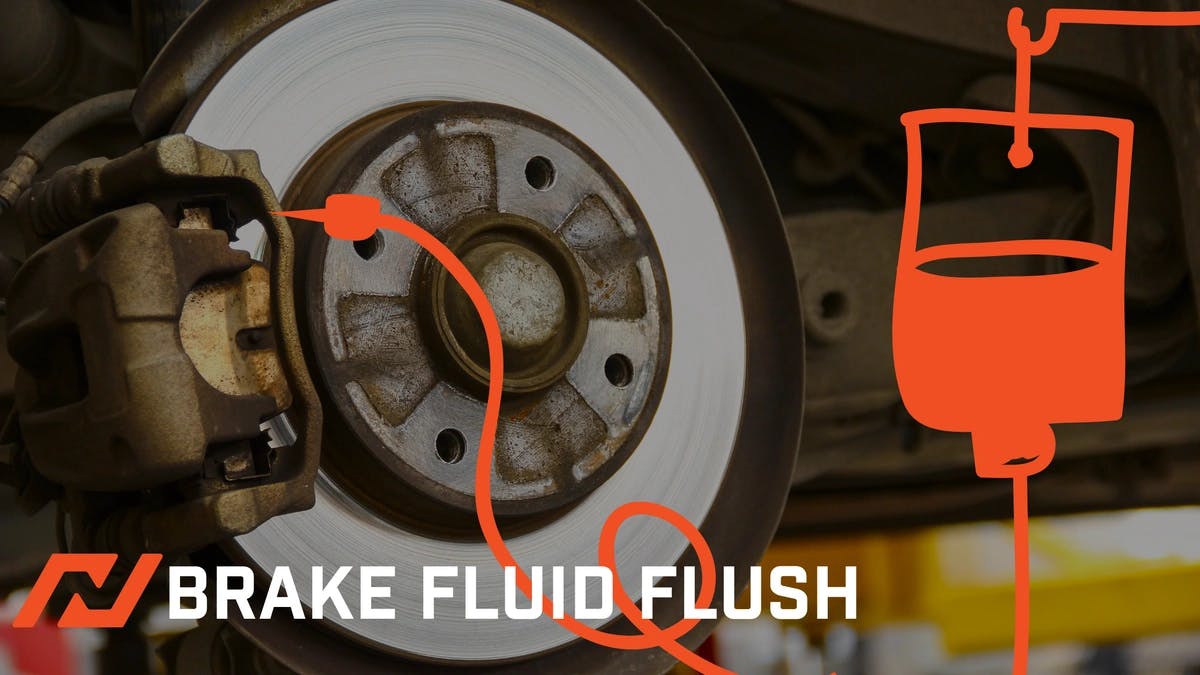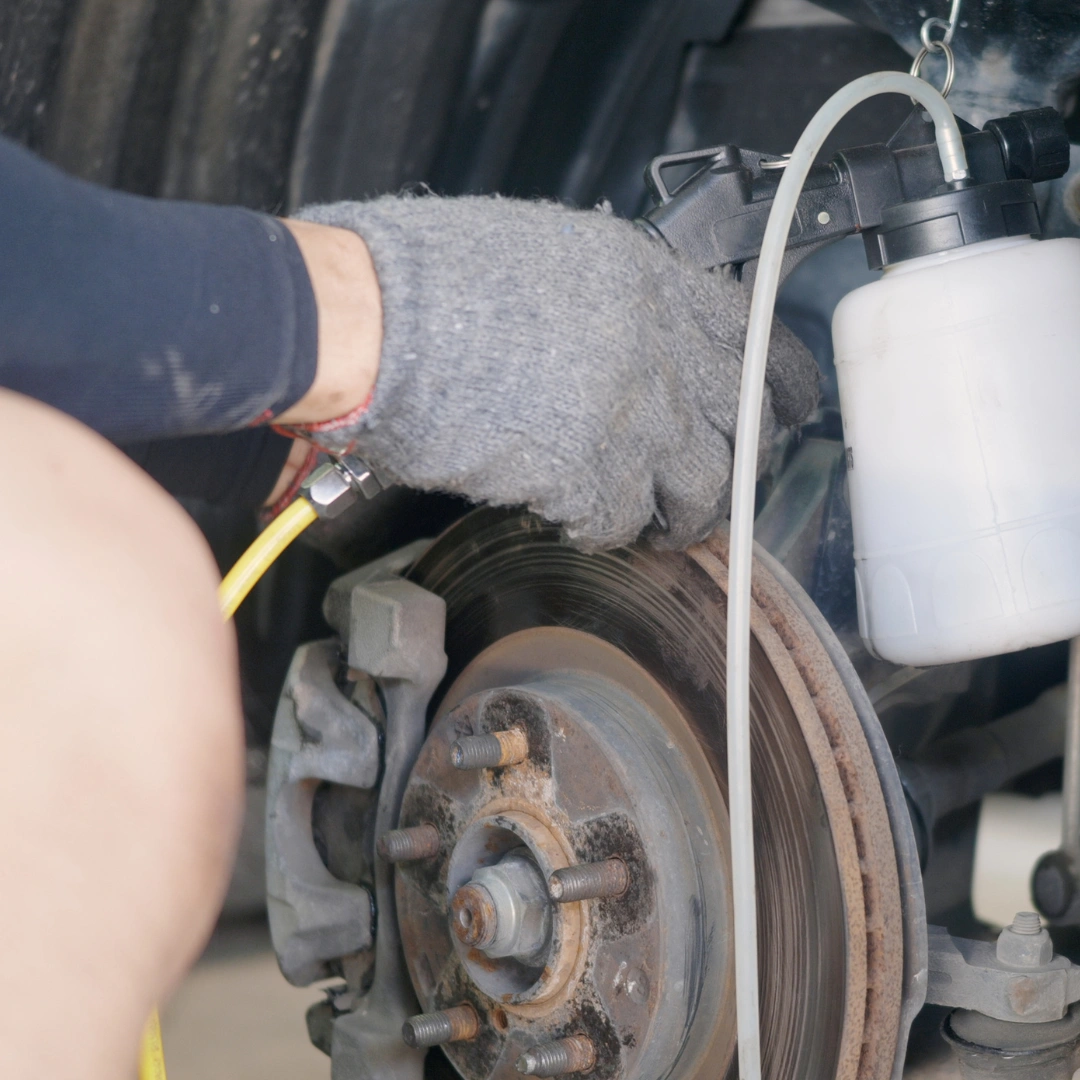Explore the process of flushing your brakes, their importance in car upkeep, and the indications that your vehicle might desperately require one.
Key Takeaways:
|
What is a Brake Fluid Flush?
A brake fluid flush replaces your old brake fluid with a new one and should be done every 30,000 miles or every 2 years to keep your brakes effective. When you press down on the brake pedal, brake fluid goes from the master cylinder into the brake lines, activating the brake pistons to apply pressure from the pads to the rotor.
When the vehicle uses a disc brake system, that fluid travels to the brake caliper pistons. These hydraulic pistons squeeze brake pads against the wheel rotor to create friction and stop the vehicle.
In a drum brake system, pressurized brake fluid forces a set of brake shoes against drums to stop the wheels.
There are two types of brake fluid flushes, regardless of whether the braking system uses drum or disc brakes:
- Chemical flush: a cleaning operation in which a chemical such as denatured alcohol is used to flush the brakes and restore the condition of brake fluid.
- Routine maintenance flush: old or dirty brake fluid is completely drained and replaced with clean brake fluid.
How Does Flushing Brake Fluid Process Work?
For us to get a better understanding of how this process works, let's have a conversation with our Mobile Brake Repair Technician:
Michael Herring |
Why is a Brake Fluid Flush Important for brake performance?
Glycol-based braking fluid is used widely in production vehicles and is "hygroscopic," which means it collects moisture that is always present in the air. Engineers estimate that absorption rates range from 1.5 to 3% in areas with normal atmospheric pressures yearly.
That rate can be considerably higher in humid climates. There's no way to prevent moisture from entering the lines through small gaps in braking hoses, seams, joints, and other components, so flushing the braking system with clean brake fluid regularly can safeguard these vital components against deterioration.
Keep in mind that brakes convert energy (forward motion) into friction, which gives off heat. That heat from the brake pads and rotors ultimately reaches the brake fluid in the hoses and pipes. Brake fluid begins to boil at lower and lower temperatures as it absorbs more water.
Therefore, a brake fluid flush replaces the old brake fluid in the master cylinder reservoir, restoring additive package levels, removing impurities, and improving brake performance.
Five Signs That You Need a Brake Fluid Flush
Brake fluid is one of those "out of sight, out of mind" automobile components often overlooked until something goes wrong. Keep an eye out for these five symptoms that your brake fluid needs to be flushed:
A Soft, Bouncy, or Spongy Brake Pedal
If the brake pedal feels soft, spongy, loose, or even bounces upon applying pressure, this can be an indicator that brake fluid needs to be replaced. Also, if the pedal must be engaged all the way before the vehicle slows or stops, it's time for a brake fluid change. Spongy brakes are caused when, over time, air enters the gaps in the brake line due to low brake fluid. This can result in a frightening and potentially dangerous experience.
ABS Dashboard Light
The appearance of the ABS dashboard light usually results from a low quantity of brake fluid and indicates that the anti-lock braking system is malfunctioning, which usually prevents the wheels from locking up when braking to prevent skids and lost traction. This should be remedied as soon as possible to prevent accidents.
Braking Performance Is Ineffective
Brake response should be swift and sensitive to ensure safety in an emergency. Anything that impedes a car’s ability to slow down or stop indicates that the brakes need to be serviced. Warped rotors, worn brake pads, or a problem with another brake system component are all possibilities.
An underlying problem, such as deteriorated tire tread, shocks, or struts, could also be the reason for ineffective braking. Nonetheless, these issues may also indicate the necessity for clean brake fluid.
A specialist can inspect the brake system and determine the best course of action to restore fully-responsive brake function.
Strange Sounds or Odors While Braking
Strange noises accompanying the pressing of the brake could mean a lack of brake fluid or another problem with the brake system. Scraping or grinding noises are also common causes of alarm.
Burning odors when braking could indicate that the brake fluid has been burned out. In this case, stop the car at a safe location and allow it to cool down. Seek advice from a professional mechanic and plan a servicing visit at the earliest opportunity. Driving with burned brake fluid can cause more catastrophic problems, like brake failure.
Routine Maintenance
Regardless of any specific incidents, rely on the suggested brake fluid replacement plan which is typically every 30,000 miles or every 2 years, to ensure that there is a reduced opportunity for issues to surface.
Keep in mind that driving habits also play a role in routine maintenance frequency. Driving shorter routes with frequent braking may necessitate more frequent brake fluid flushes.
Any brake fluid information particular to the make and model of a vehicle can be found in the owner's handbook.
FAQs about brake fluid flush answered by experts in the field
Will changing brake fluid improve braking?
Yes, changing brake fluid can improve braking performance. As time passes, brake fluid may accumulate moisture and dirt, leading to a lowered boiling point and diminished brake performance. By replacing the brake fluid and cleansing the system, the efficiency and responsiveness of the braking system can be reinstated. It is recommended by car manufacturers to change brake fluid every two years to ensure optimal braking performance.
How much is a Brake Fluid Flush?
The cost of a brake fluid flush typically ranges between $70 to $120, depending on your vehicle's make and model and the rates of the service center. Always remember investing in regular maintenance can save you from more expensive repairs down the line. See also Brake Fluid Change Cost.
How long does a brake flush take?
A brake flush typically takes about 30 minutes to an hour, but the exact time can vary depending on your vehicle's make and model, the condition of your brake system, and the tools used. Unique brake system designs, and any existing corrosion or damage can prolong the process. Specialized equipment like brake-flushing machines can expedite this service.
Can I flush the brake fluid myself?
The short answer is Yes, You CAN.
While you can technically flush the brake fluid yourself, it requires considerable mechanical skill and proper disposal due to its environmental impact. Considering the critical role of the brake system in your safety, it's generally best to give this task to professional mechanics with the necessary tools and experience.
What's dirty brake fluid look like?
Dirty brake fluid often appears dark brown or black, a stark contrast to new brake fluid which typically has a clear, amber-yellow color. The darker color indicates contamination and degradation, signaling it's time for a brake fluid flush.
Can you add new brake fluid to the old one?
While you technically can add new brake fluid to old, it's not recommended. Mixing new fluid with old can dilute the contaminants but doesn't eliminate them, potentially compromising the performance and safety of your braking system. A full brake fluid flush is the best practice.
How many times can you bleed the brakes?
There isn't a specific limit to how many times you can bleed the brakes. It should be done until all air is removed from the brake lines, ensuring only fluid is present. However, frequent need for bleeding might indicate a problem with your brake system that should be professionally inspected.
What happens if you accidentally put water in your brake fluid?
Adding water to your brake fluid can be highly dangerous. Water lowers the boiling point of the brake fluid, which can lead to vapor lock (steam in the system), resulting in brake failure. It can also cause internal rust and corrosion. If water is accidentally added, a full brake fluid flush is necessary immediately.
Final Thoughts
A brake fluid flush helps preserve brake efficiency and prevent corrosion by replacing old or contaminated brake fluid. As brake system components deteriorate over time, changing the brake fluid regularly can make your automobile safer and improve the life of your brake components and save money in the long run.
If you're looking for the most convenient automobile service experience, NuBrakes makes brake repair convenient and affordable for everyone by combining our mobile model with the personal, friendly touch of our certified brake repair technicians.
We believe in delivering more than just brake repair, we believe in providing the very best customer service, customer experience, and company culture for every team member.
Contact us today to get a free quote from our team.
References:
- https://www.attrelltoyota.com/importance-flushing-brake-fluid/
- https://rivergatemuffler.com/2020/12/what-are-the-benefits-of-brake-fluid-flushes/
- https://www.oceanmazda.com/what-is-a-brake-fluid-flush-doral-fl/
- https://www.cbac.com/media-center/blog/2021/december/here-s-what-you-need-to-know-about-brake-fluid/


